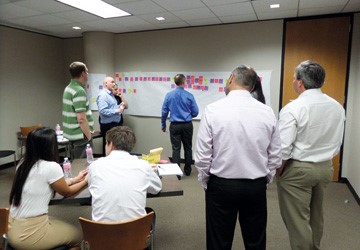Triaster's process mapping software - Process Navigator - is now available free of charge.
Process Navigator is the ultimate drag-and-drop process mapping software, and is both full of functionality and really easy to use. In this article we celebrate that the latest version can be used for free and explore how to process map with Process Navigator.
Process Mapping with Triaster's Process Navigator
A process map is a way to describe how things are done. It can be thought of as a ‘User Guide’ to your organisation; it is the manual that shows how your organisation operates and provides employees with all the information they need to best do their jobs.
(For more information on process maps and why to process map, please read this article: What is Process Mapping, Who Does it and Why Use it?)
There are many ways to process map however and some can deliver a very complex picture, which far from helping with process improvement, just confuse most people.
To address this problem, Triaster developed the Noun-Verb process mapping methodology. This is a powerful, yet very simple way to document business processes. It has been thoroughly proven in hundreds of organisations to deliver process diagrams that are useful to a widespread, non-specialist workforce, and at the same time, also useful to business analysts.
The Noun-Verb methodology perfectly balances out the need for simple, comprehensible process diagrams, that are also at the same time sufficiently detailed to enable the identification and analysis of performance improvement opportunities. To learn more about it, please read this article: Noun-Verb: A Simple Process Mapping Methodology
Triaster also developed the process mapping software - Process Navigator - to work with the Noun-Verb process mapping methodology.
In Process Navigator:
- An Activity shape is used to describe something you do - Activities are the steps of the process and are described using verbs.
- A Deliverable shape is used to describe something you produce - Deliverables are the items produced (or ‘delivered’) when each step of the process is complete and are described using nouns.
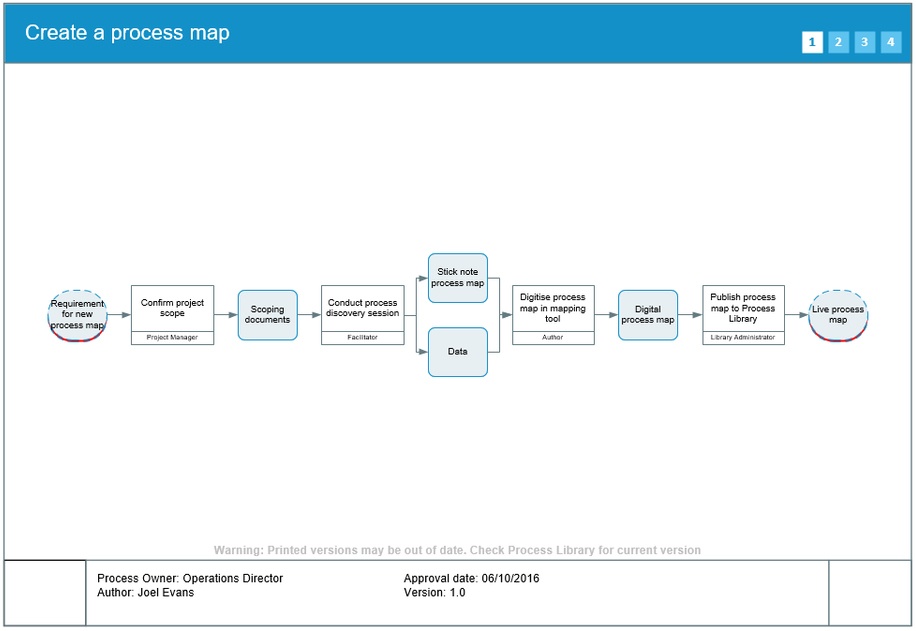
Preparing to Process Map
Before you sit down at your p.c. and start connecting shapes together however, it is a good idea to have the process already scoped out. At Triaster, we suggest running process discovery sessions.
Make sure you invite the correct people to the sessions and ensure that the sessions are lively and fun to attend. You should end each session having captured the detail of a process, from the people who know it best - those that do it on a daily basis.The next step is to map the process using Triaster’s process mapping software: Process Navigator.
Opening and using Microsoft Visio with Process Navigator
Process Navigator uses Microsoft Visio as its process mapping tool. Process Navigator sits on top of Visio and provides some functional process mapping foundations, as well as useful software features and shareable Stencil, Template and Properties files for all to use.
To open Visio from Process Navigator to enable you to create a new process map, click the New Visio Process icon towards the top left of Process Navigator.
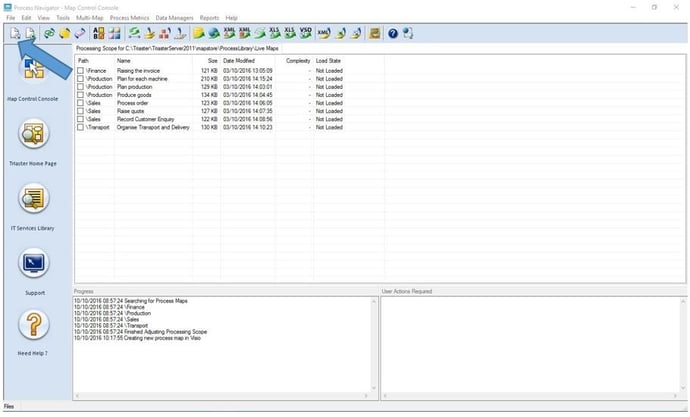
You can also edit an existing process map by right clicking the map and selecting Edit in Visio.
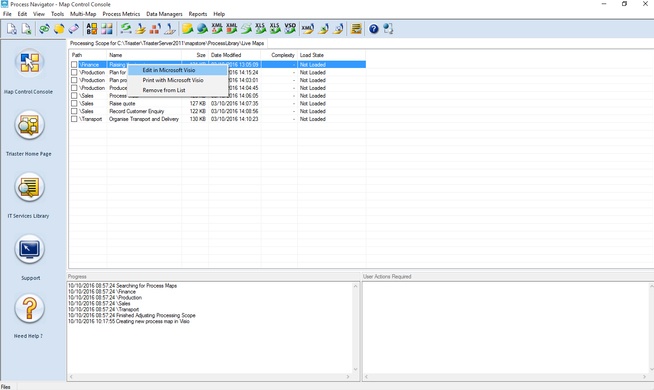
Take a look at these tips for working in Microsoft Visio, the keyboard shortcuts are extremely useful.
Creating a Map: Using the Shapes
As you can see, the Stencil is on the left hand side of the screen by default. And from here, you can drop shapes on the page one by one.
Using the Noun-Verb methodology, all Triaster process maps start with a Deliverable and as you can see from the Stencil there are different types of Deliverable:
- Start/End Deliverable - this is an ultimate start point
- Handover Deliverable - this is a start point that has been handed over from another department
- External Deliverable - this is a start point that has appeared from outside the organisation
- Deliverable - this is for internal handovers
For a detailed explanation of Process Navigator shapes, please read the article: Process Mapping Symbols: The Key to Making Process Maps
Click and drag a Deliverable from your Stencil, and drop it somewhere on the left hand side of your Visio page, you will then be able to type within the shape to name it.
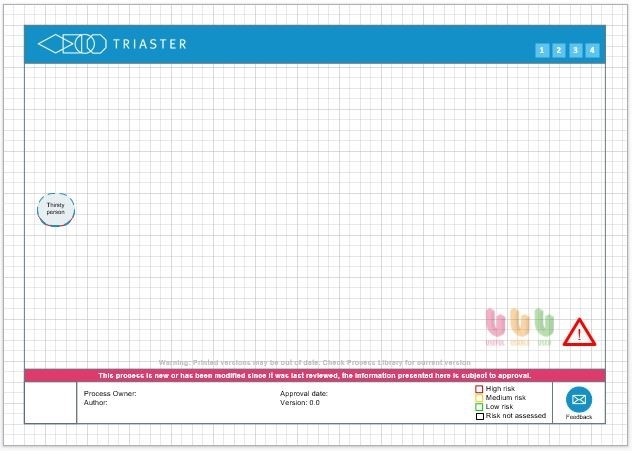
After each Deliverable, the Noun-Verb process mapping methodology requires an Activity. You can see on the Stencil above that there are three types of Activity:
- Activity – Used for activities carried out within the organisation
- External Activity – Used for activities carried out outside of the organisation
- Decision – Used where there is an exclusive output produced out of multiple available outputs
Drag on an Activity from the Stencil, drop it next to the Deliverable and then you will be able to type in the shape to describe the activity.
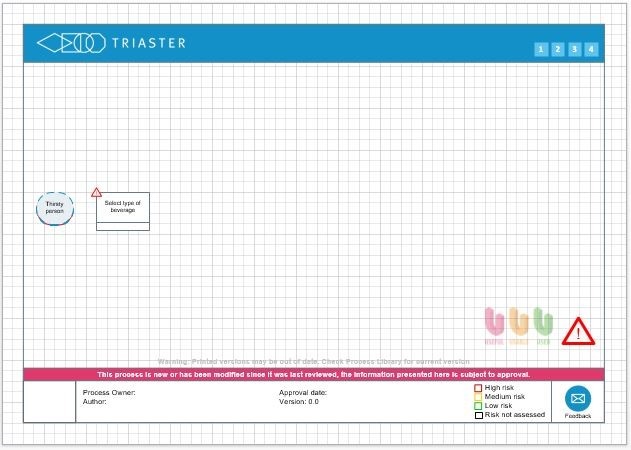
Then, as you would expect, following each Activity the Noun-Verb methodology requires a Deliverable (or multiple Deliverables if more than one output is produced).
Process mapping in this way, makes the reason for carrying out the preceding Activity absolutely obvious, it shows clearly what is produced as a result of somebody executing the Activity.
Sometimes specifying a Deliverable after each Activity can seem like stating the obvious, but that is because there is an obvious output to the Activity. If the output is not as obvious, then that could suggest that the Activity being carried out has no obvious purpose and could be wasteful.
For detail on the 3 major benefits of the Noun-Verb methodology, please read: Noun-Verb: A Simple Process Mapping Methodology
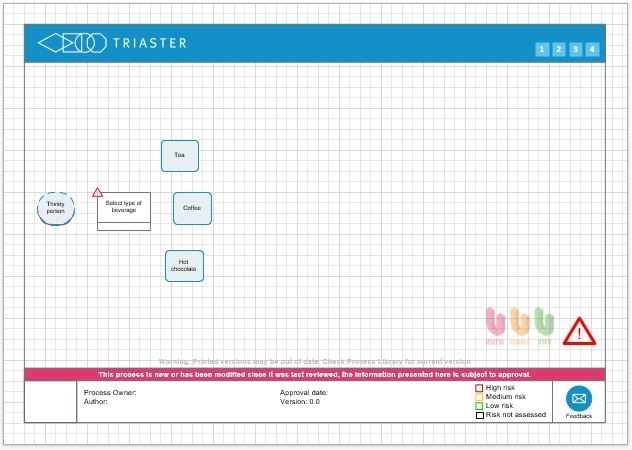
Follow the method, dropping the shapes one by one, specifying an input and an output Deliverable for each Activity that you place on the page, until you have produced the ultimate output - in this case a hot beverage.
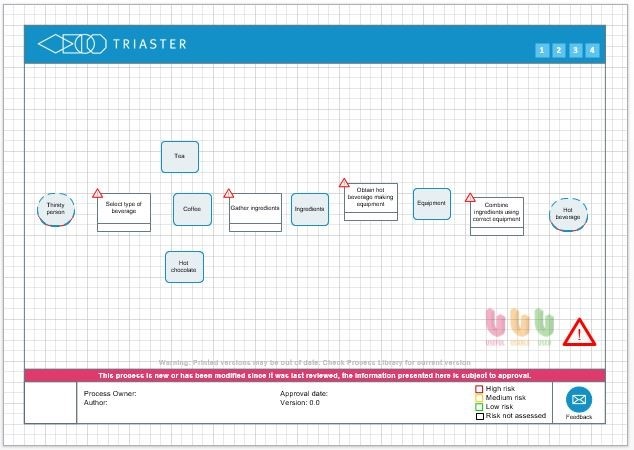
Don’t worry if your shapes are not lined up, we have a tool to help with that a bit later on.
Creating a Map: Connecting Shapes Together
Once you have the shapes on the page, in the correct order, you need to connect them together. There are three ways to do this, using there different tools:
- Microsoft Visio's Connect Shapes tool
- Triaster’s Connector Tool
- Microsoft Visio’s Connector Tool
Connect Shapes tool
To use this tool, you’ll need to add it to your Quick Access Ribbon.
Use the Ctrl or Shift key to multi-select the shapes in the order that you want them to be connected.
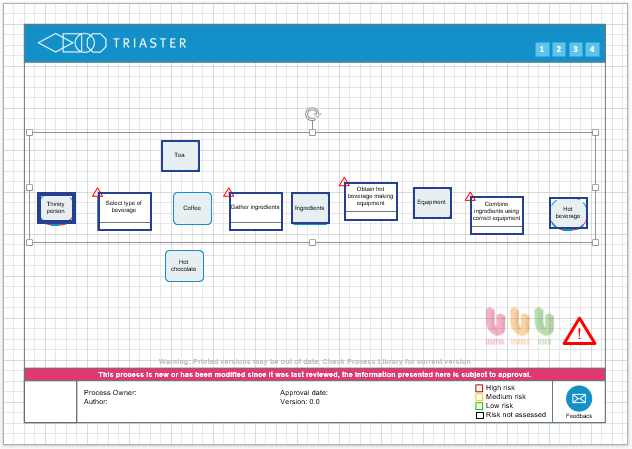
Once they are selected, click Connect Shapes.
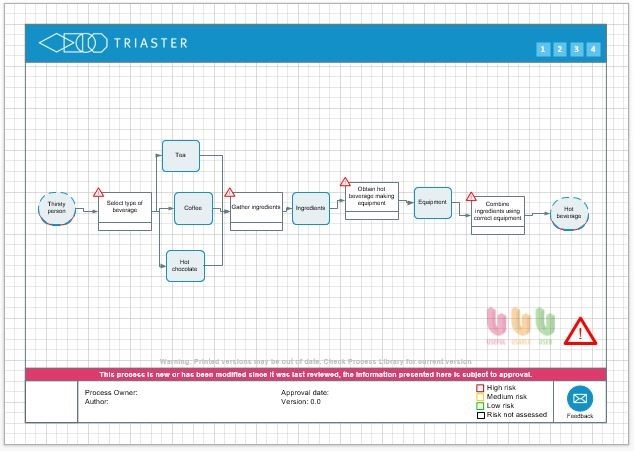
Triaster’s Connector Tool
Another method of connecting the shapes on your process map is to use the connection options that are available when you right click a shape and click Properties.
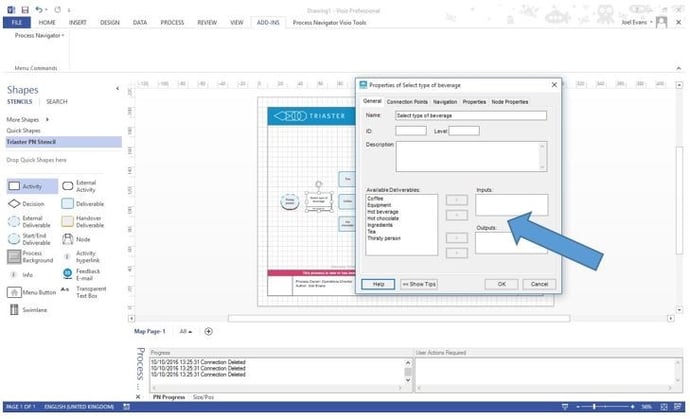
This feature enables you to choose the inputs and outputs per Activity in one go, and ensures that the connectors are snapped on to the connection points.
Microsoft Visio’s Connector Tool
Visio has a Connector Tool on the ribbon by default. It is located just below the Pointer Tool. To use this feature, select the Connector Tool, and click and drag from the connection point on the right hand side of a shape into the left hand side of another shape. You have to be careful using this method – it is easy to miss a connection point, and the Triaster system required the connectors to be snapped on to the connection points.
Creating a Map: Making it Look Great!
Process Navigator has an Auto-Layout feature that will tidy your process map up for you. As long as your map is not too complex to start with, Process Navigator does a good job of reassembling the shapes to look their best. To use this feature, click Add-Ins, Process Navigator and then Auto-Layout.
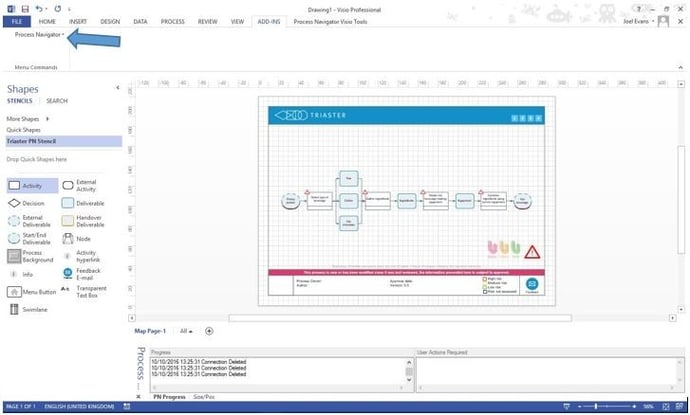
Completing your Process Map
Title
Next you need to give your map a title, the Noun-Verb methodology advocates that this should start with a verb. The name of the process we have been mapping is 'Make a hot beverage'. To give your map a title, click in the title bar on the Node (the Node is the frame of the page) and start typing.
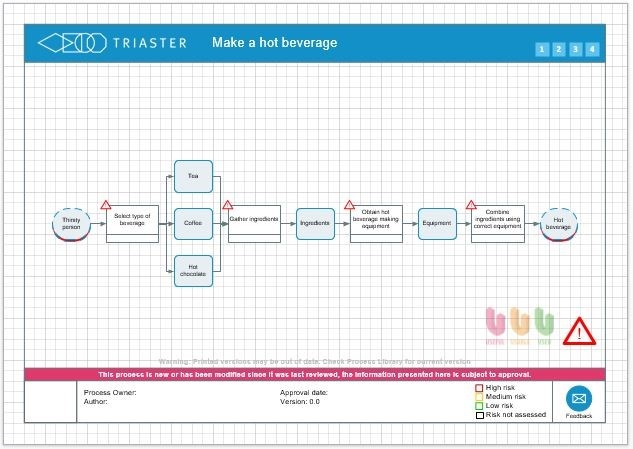
Properties
You may have noticed the red warning triangles on my process map. This is a feature to remind you that there are mandatory properties missing from the shapes. Contact us if you want to enable this feature. The red warning triangles disappear once the mandatory properties have been filled out.
Properties is the meta data that is stored behind each of the shapes. This is customisable and you can record as many properties per shape as you wish. To fill out the properties, right click on the shapes, click on Properties, and then fill out the desired fields. All of the properties can be reported on or searched when the process map is published to a Triaster process library.
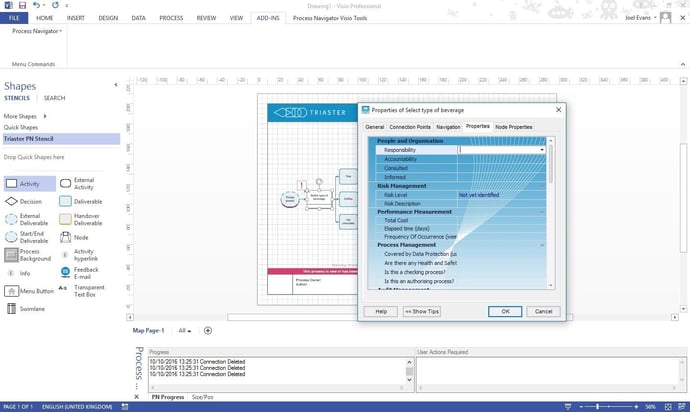
Once the properties have been filled out, your process map is complete.
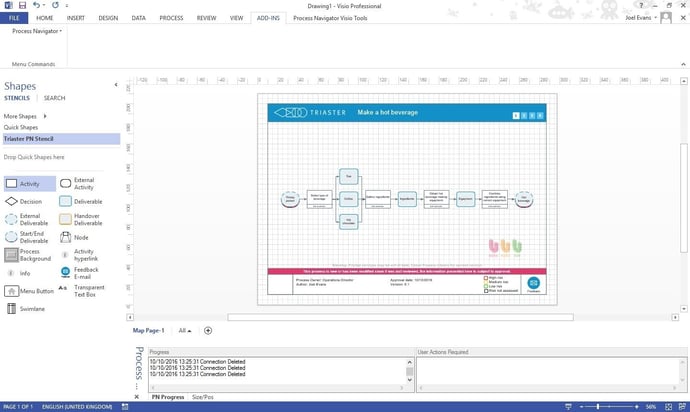
Further help with Process Mapping with Process Navigator
We hope that this article has given you a head start with creating simple and yet extremely useful process maps, using Process Navigator.
If you haven't already, download Process Navigator now, by clicking on this link or the Download button below. Triaster's process mapping software can be used for free, for ever.
In addition, if you are a Triaster BPM System customer of Triaster, you can unlock additional process mapping functionality to maximise the value of your Triaster BPM system. For details of this additional functionality please look here: Process Navigator pricing
For further help with process mapping with Process Navigator, sign up for the Triaster Software Foundation course. Full details of all Triaster's e-learning courses can be found here: E-learning courses
You will also find our Process Mapping Checklist and The Ultimate Guide to Business Process Mapping extremely helpful.
Other Related Articles:
3 Time-Saving Tips for Microsoft Visio Process Mapping
Noun-Verb: A Simple Process Mapping Methodology
Process Mapping Symbols: The Key to Making Process Maps
Capturing a Business Process: 3 Tips for Process Discovery WorkshopsWritten by Emma Harris
Emma was Operations Director for Triaster for nearly 20 years, during which time as well as learning and perfecting her BPM and process improvement skills, she honed her inbound marketing expertise. She now runs D2e - Designed to engage - which designs and develops bespoke, engaging, HubSpot CMS websites, that help your entire company to grow and scale. She is delighted to still be delivering Triaster's marketing, whilst also helping other companies turn their websites into their hardest working asset.


